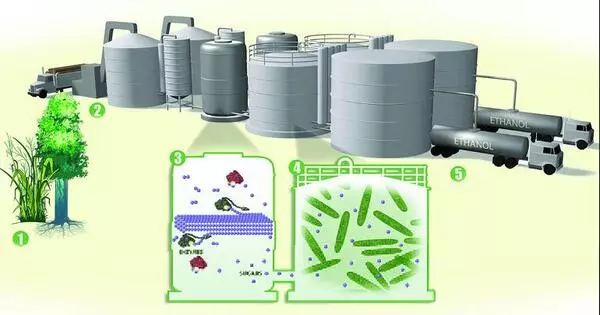Cellulosic ethanol is a form of biofuel derived from plant cellulose and hemicellulose, primarily from non-food, lignocellulosic biomass sources such as agricultural leftovers, wood, and specific energy crops. It is ethanol (ethyl alcohol) derived from cellulose (a plant’s stringy fiber) rather than the plant’s seeds or fruit. It is made from grasses, wood, algae, and other plants.
It is commonly discussed as a biofuel. Because the carbon dioxide absorbed by plants while growing balances some of the carbon dioxide emitted when ethanol created from them is consumed, cellulosic ethanol fuel has the potential to have a lower carbon footprint than fossil fuels. Unlike first-generation biofuels like corn ethanol, which are made from the edible sections of plants, cellulosic ethanol is made from the non-food parts of plants, making it a potentially more sustainable and environmentally friendly fuel source.
Cellulosic ethanol is gaining popularity due to its potential to replace ethanol derived from corn or sugarcane. Because these plants are also used to make food, diverting them for ethanol production may raise food prices; cellulose-based sources, on the other hand, do not compete with food because the fibrous sections of plants are mainly inedible to humans.
Another possible benefit is the variety and diversity of cellulose supplies; grasses, trees, and algae can be found in practically every ecosystem on Earth. Even municipal solid waste components such as paper might theoretically be converted into ethanol. Cellulosic ethanol’s main present disadvantage is its high manufacturing cost, which is more complex and needs more stages than corn- or sugarcane-based ethanol.
The production of cellulosic ethanol involves several steps:
- Feedstock Collection: Crop residues (e.g., maize stover, wheat straw), forestry residues, and energy crops (e.g., switchgrass, miscanthus) are all collected and processed for processing.
- Pretreatment: The lignin and hemicellulose components of biomass are broken down, making the cellulose more available for enzymatic and microbial conversion. Steam explosion, acid hydrolysis, and alkaline hydrolysis are all common pretreatment procedures.
- Enzymatic Hydrolysis: Enzymes are utilized after pretreatment to break down the cellulose into its constituent sugars, principally glucose. Enzymatic hydrolysis is an important step in the release of sugars from the cellulose matrix.
- Fermentation: The sugar-rich solution produced by enzymatic hydrolysis is subsequently fermented by microorganisms, typically yeast or bacteria, to convert the carbohydrates to ethanol.
- Distillation: The fermented mixture is distilled to separate the ethanol from water and other byproducts, resulting in high-purity ethanol.
Cellulosic ethanol offers several advantages:
- Reduced Competition with Food Crops: Since it uses non-food biomass sources, it does not compete with the production of food crops for arable land.
- Lower Greenhouse Gas Emissions: It has the potential to reduce greenhouse gas emissions compared to fossil fuels, especially when the feedstock is sustainably sourced.
- Utilization of Waste Materials: It can make use of agricultural and forestry residues that might otherwise go to waste.
- Energy Independence: It can contribute to reducing a nation’s dependence on imported fossil fuels.
- Improved Energy Efficiency: The whole process can be more energy-efficient compared to first-generation ethanol production.















